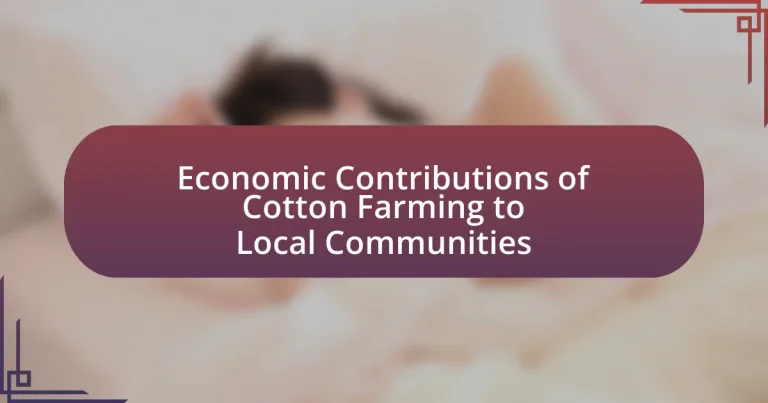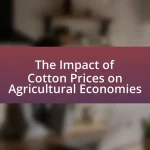Cotton farming plays a crucial role in the economic development of local communities by providing employment, generating income, and stimulating local economies. This article examines the various economic contributions of cotton farming, including job creation, financial benefits for farmers, and its impact on community development and infrastructure improvements. It also addresses the challenges faced by local farmers, such as market fluctuations and environmental factors, while highlighting the support systems available to enhance the sustainability and profitability of cotton farming. Additionally, the article explores best practices that communities can adopt to maximize the benefits derived from cotton cultivation.
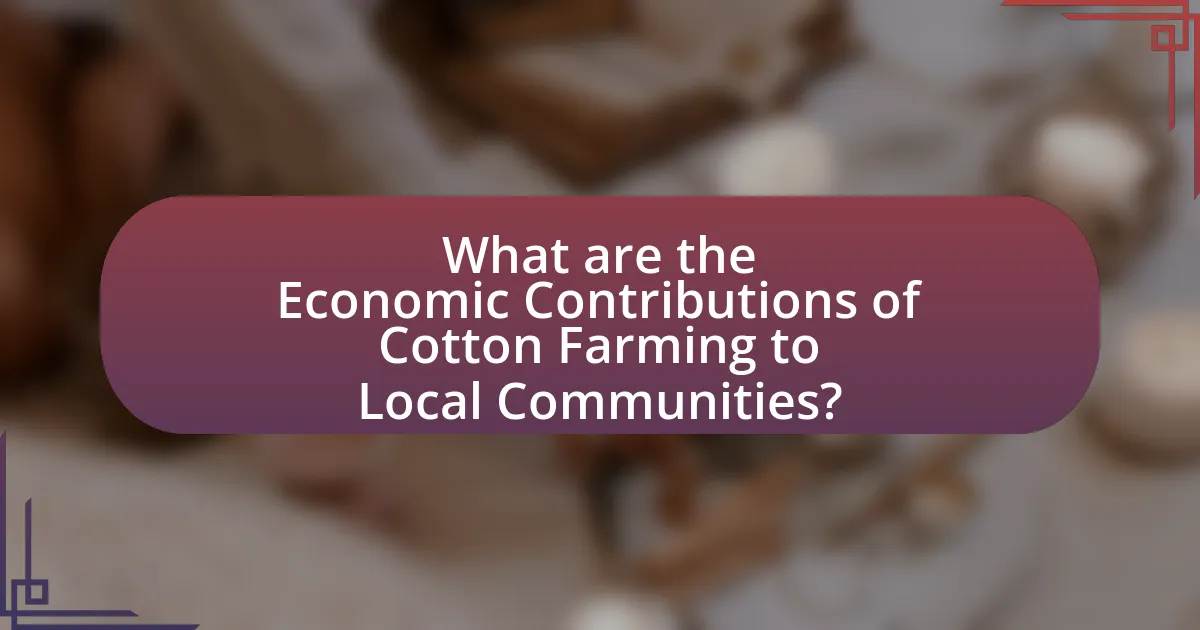
What are the Economic Contributions of Cotton Farming to Local Communities?
Cotton farming significantly contributes to local communities by providing employment, generating income, and stimulating local economies. In regions where cotton is cultivated, it creates jobs for thousands of workers, from planting to harvesting, which directly supports families and enhances their livelihoods. For instance, in countries like India, the cotton industry employs over 60 million people, making it a vital source of income for many households. Additionally, cotton farming stimulates local economies through the purchase of seeds, fertilizers, and equipment, as well as through the establishment of processing facilities that further enhance economic activity. The revenue generated from cotton sales also contributes to local government budgets, enabling investment in community services and infrastructure.
How does cotton farming impact local economies?
Cotton farming significantly impacts local economies by providing employment opportunities and generating income for farmers and related industries. In regions where cotton is a primary crop, such as the United States and India, it supports millions of jobs in farming, processing, and distribution. For instance, in the U.S., the cotton industry contributes approximately $25 billion annually to the economy, highlighting its role in local economic stability. Additionally, cotton farming stimulates local businesses, including equipment suppliers and textile manufacturers, further enhancing economic activity. This interconnectedness illustrates how cotton farming serves as a vital economic engine for many communities.
What are the direct financial benefits of cotton farming for local farmers?
Cotton farming provides direct financial benefits to local farmers through increased income from cotton sales, which can significantly enhance their economic stability. Farmers often earn higher prices for cotton compared to other crops, leading to improved profit margins. For instance, in countries like India, cotton farmers can earn up to 30% more than those cultivating traditional crops, as reported by the Food and Agriculture Organization. Additionally, cotton farming creates job opportunities in related sectors, such as ginning and textile production, further contributing to local economies. This interconnectedness boosts overall financial resilience for farming communities.
How does cotton farming influence local job creation?
Cotton farming significantly influences local job creation by providing employment opportunities in various sectors, including agriculture, processing, and retail. The cultivation of cotton requires a substantial labor force for planting, tending, and harvesting, which directly creates jobs for local workers. According to the International Cotton Advisory Committee, cotton production supports approximately 100 million jobs worldwide, with many of these positions concentrated in rural areas where cotton is grown. Additionally, the processing of cotton into textiles and other products further generates employment in factories and related industries, enhancing the economic stability of local communities.
What role does cotton farming play in community development?
Cotton farming plays a significant role in community development by providing employment opportunities and generating income for local farmers. In regions where cotton is cultivated, it often serves as a primary cash crop, contributing to the economic stability of households. For instance, in countries like India and Uzbekistan, cotton farming supports millions of farmers and their families, directly impacting their livelihoods and enabling them to invest in education and healthcare. Additionally, the cotton industry stimulates local economies through the establishment of processing facilities and related businesses, further enhancing community infrastructure and services.
How does cotton farming contribute to infrastructure improvements?
Cotton farming contributes to infrastructure improvements by driving investments in transportation, irrigation, and processing facilities. The establishment of cotton farms often necessitates the development of roads and railways to facilitate the movement of goods, which enhances local connectivity. For instance, in regions like West Africa, the expansion of cotton production has led to the construction of over 1,000 kilometers of rural roads, improving access to markets and services. Additionally, the need for efficient water management systems for irrigation has prompted investments in water infrastructure, benefiting not only cotton farmers but also local communities. This dual benefit is evident in countries such as India, where cotton farming has spurred the development of irrigation canals that support both agricultural and domestic water needs.
What social programs are funded by the profits from cotton farming?
Profits from cotton farming fund various social programs, including education initiatives, healthcare services, and community development projects. For instance, in countries like India and West Africa, cotton revenues have been allocated to improve local schools, provide scholarships for students, and enhance healthcare facilities. Additionally, some cotton cooperatives reinvest profits into infrastructure projects, such as clean water access and sanitation improvements, which directly benefit farming communities. These allocations demonstrate the significant role that cotton farming profits play in supporting essential social services and enhancing the quality of life in local areas.
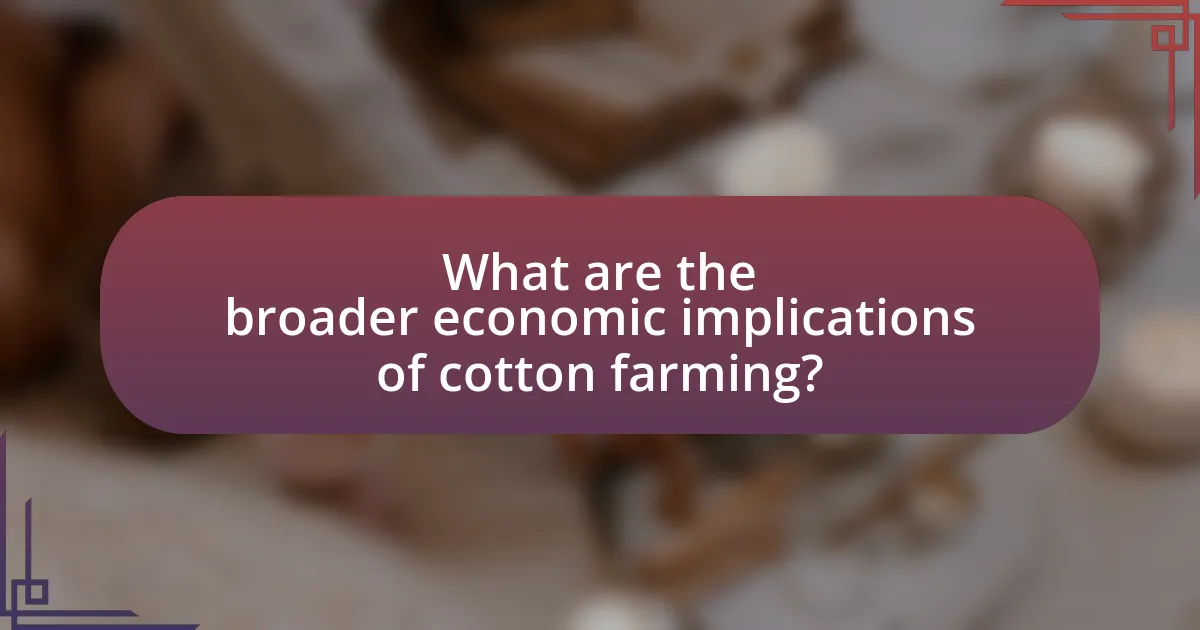
What are the broader economic implications of cotton farming?
Cotton farming has significant broader economic implications, including job creation, income generation, and contributions to local and national economies. The cotton industry supports millions of jobs globally, with approximately 250 million people involved in cotton production, processing, and trade. This sector generates substantial income for farmers and workers, contributing to rural development and poverty alleviation. In countries like India and the United States, cotton farming is a vital part of the agricultural economy, influencing trade balances and providing raw materials for the textile industry, which is valued at over $1 trillion globally. Additionally, cotton farming stimulates related industries, such as ginning, spinning, and weaving, further enhancing economic activity and employment opportunities in local communities.
How does cotton farming affect regional trade?
Cotton farming significantly impacts regional trade by enhancing local economies through increased agricultural exports. Regions that cultivate cotton often see a boost in trade balance as cotton is a high-demand commodity in global markets, with countries like the United States, India, and China being major exporters. For instance, in 2021, the global cotton trade was valued at approximately $50 billion, illustrating its importance in international commerce. Additionally, cotton farming creates jobs in related sectors such as processing, transportation, and retail, further stimulating regional economic activity. This interconnectedness between cotton production and trade underscores the vital role of cotton farming in shaping local economies and trade dynamics.
What are the export opportunities associated with cotton farming?
Export opportunities associated with cotton farming include the sale of raw cotton, cotton yarn, and finished textile products to international markets. The global demand for cotton products is significant, with countries like China, India, and Bangladesh being major importers. In 2021, the global cotton market was valued at approximately $50 billion, highlighting the economic potential for exporting cotton and its derivatives. Additionally, value-added products such as organic cotton and sustainable textiles are increasingly sought after, providing farmers with avenues to tap into niche markets. These opportunities can enhance local economies by increasing income for farmers and creating jobs in processing and manufacturing sectors.
How does cotton farming influence local supply chains?
Cotton farming significantly influences local supply chains by creating demand for various agricultural inputs and services, which stimulates local economies. The cultivation of cotton requires seeds, fertilizers, pesticides, and machinery, leading to increased business for local suppliers and service providers. For instance, in regions like Texas, the cotton industry supports over 100,000 jobs and contributes approximately $1.6 billion to the local economy through these supply chain activities. Additionally, cotton farming fosters relationships between farmers and local ginners, who process the cotton, further integrating local economies and enhancing the overall economic stability of the community.
What are the environmental and economic sustainability aspects of cotton farming?
Cotton farming has significant environmental and economic sustainability aspects. Environmentally, sustainable cotton farming practices, such as organic farming and integrated pest management, reduce chemical usage, conserve water, and promote biodiversity. For instance, organic cotton farming uses 91% less water compared to conventional methods, as reported by the Textile Exchange in their 2021 Organic Cotton Market Report. Economically, cotton farming supports local economies by providing jobs and income for millions of farmers globally. In countries like India, cotton farming contributes to the livelihoods of approximately 5 million farmers, enhancing rural development and economic stability. These practices collectively promote a balance between ecological health and economic viability in cotton farming.
How can sustainable practices in cotton farming enhance economic contributions?
Sustainable practices in cotton farming can enhance economic contributions by increasing yield efficiency and reducing costs associated with inputs like water and pesticides. For instance, implementing crop rotation and organic farming techniques can lead to healthier soil and higher productivity, which directly boosts farmers’ income. According to a study published in the Journal of Cleaner Production, sustainable cotton farming practices can increase profitability by up to 30% compared to conventional methods, as they lower input costs and improve market access through certifications. This economic benefit not only supports individual farmers but also strengthens local economies by creating jobs and fostering community development initiatives.
What are the long-term economic risks associated with cotton farming?
The long-term economic risks associated with cotton farming include market volatility, environmental degradation, and dependency on monoculture practices. Market volatility can lead to fluctuating prices, which affects farmers’ income stability; for instance, cotton prices have historically experienced significant swings, impacting profitability. Environmental degradation, such as soil depletion and water scarcity, can reduce agricultural productivity over time, as seen in regions where intensive cotton farming has led to the depletion of natural resources. Additionally, reliance on monoculture can increase vulnerability to pests and diseases, which may result in crop failures and economic losses. These factors collectively threaten the sustainability of cotton farming and its economic contributions to local communities.
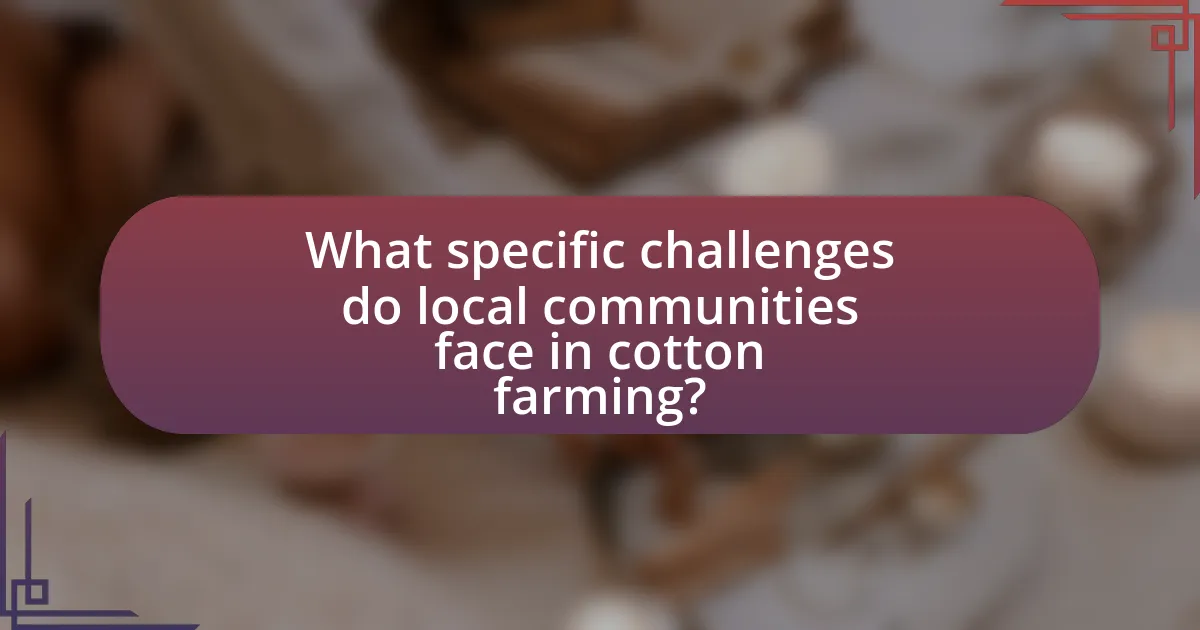
What specific challenges do local communities face in cotton farming?
Local communities face several specific challenges in cotton farming, including water scarcity, pest management, and fluctuating market prices. Water scarcity significantly affects cotton yield, as cotton requires substantial irrigation; for instance, regions like India have reported severe water shortages impacting production. Pest management is another critical challenge, with pests such as the cotton bollworm causing significant crop losses; studies indicate that pest infestations can reduce yields by up to 50%. Additionally, fluctuating market prices create economic instability for farmers, as prices can vary widely based on global demand and supply conditions, leading to financial uncertainty for local communities reliant on cotton as their primary income source.
How do market fluctuations impact local cotton farmers?
Market fluctuations significantly impact local cotton farmers by directly affecting their income and production decisions. When cotton prices rise, farmers are incentivized to increase production, leading to higher revenues. Conversely, when prices fall, farmers may face financial strain, resulting in reduced planting and potential crop loss. For instance, in 2021, cotton prices surged to over $1 per pound, prompting farmers to expand their acreage. However, in 2022, prices dropped to around $0.80 per pound, causing many farmers to reconsider their planting strategies and potentially leading to lower overall production. This volatility can also affect farmers’ ability to invest in necessary resources, such as seeds and equipment, thereby influencing the long-term sustainability of their operations.
What strategies can local farmers employ to mitigate market risks?
Local farmers can mitigate market risks by diversifying their crops and implementing risk management tools such as crop insurance. Diversification reduces dependency on a single crop, thereby spreading risk across multiple revenue sources. For instance, farmers growing cotton can also cultivate soybeans or corn, which can provide alternative income streams during market fluctuations. Additionally, utilizing crop insurance can protect farmers against losses due to adverse weather conditions or price drops, as evidenced by the USDA’s Risk Management Agency, which reports that insured farmers are more resilient to market volatility. These strategies collectively enhance financial stability and reduce vulnerability to market changes.
How do climate change and environmental factors affect cotton farming?
Climate change and environmental factors significantly impact cotton farming by altering weather patterns, affecting crop yields, and increasing pest and disease prevalence. Rising temperatures can lead to heat stress in cotton plants, reducing their growth and fiber quality. Additionally, changes in precipitation patterns can result in either drought or excessive rainfall, both of which can hinder cotton production. For instance, a study published in the journal “Agricultural Systems” indicates that a 1°C increase in temperature could reduce cotton yields by up to 10%. Furthermore, increased carbon dioxide levels may initially boost growth but can also exacerbate pest populations, leading to higher pesticide use and costs for farmers. These factors collectively threaten the economic viability of cotton farming, which is crucial for local communities that rely on it for income and employment.
What support systems are available for local cotton farmers?
Local cotton farmers have access to various support systems, including government subsidies, agricultural extension services, and cooperative organizations. Government subsidies often provide financial assistance for inputs such as seeds and fertilizers, which can enhance productivity. Agricultural extension services offer training and resources to improve farming techniques and pest management, thereby increasing yields. Additionally, cooperative organizations enable farmers to pool resources, access markets, and negotiate better prices for their cotton, fostering economic stability within local communities. These support systems collectively contribute to the sustainability and profitability of cotton farming, which is vital for the economic contributions of this sector to local economies.
How can local governments assist in enhancing the economic contributions of cotton farming?
Local governments can enhance the economic contributions of cotton farming by implementing supportive policies, providing financial assistance, and investing in infrastructure. For instance, local governments can offer subsidies or grants to cotton farmers, which can increase production efficiency and profitability. Additionally, establishing cooperative programs can help farmers access better resources and markets, thereby boosting their economic output. Investing in irrigation systems and transportation infrastructure can also facilitate the distribution of cotton products, reducing costs and increasing market access. According to the Food and Agriculture Organization, improved infrastructure can lead to a 20% increase in agricultural productivity, demonstrating the significant impact of local government initiatives on the cotton farming economy.
What role do cooperatives play in supporting cotton farmers?
Cooperatives play a crucial role in supporting cotton farmers by providing them with access to resources, markets, and financial services. These organizations enable farmers to pool their resources, which enhances their bargaining power when purchasing inputs like seeds and fertilizers, thereby reducing costs. Additionally, cooperatives facilitate collective marketing, allowing farmers to sell their cotton at better prices by aggregating their produce, which increases their competitiveness in the market. Research indicates that cooperatives can lead to a 20-30% increase in income for cotton farmers compared to those who do not participate in such organizations. This economic uplift not only benefits individual farmers but also contributes to the overall economic development of local communities reliant on cotton farming.
What best practices can local communities adopt to maximize the benefits of cotton farming?
Local communities can maximize the benefits of cotton farming by implementing sustainable agricultural practices, such as crop rotation, integrated pest management, and efficient water use. These practices enhance soil health, reduce dependency on chemical inputs, and improve yield stability. For instance, crop rotation can increase soil fertility and reduce pest populations, leading to higher cotton yields and lower production costs. According to a study by the Food and Agriculture Organization, sustainable practices can increase cotton yields by up to 30% while reducing environmental impact. Additionally, local communities should invest in training programs for farmers to adopt these practices effectively, ensuring long-term economic benefits and resilience in cotton farming.
